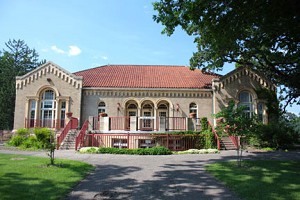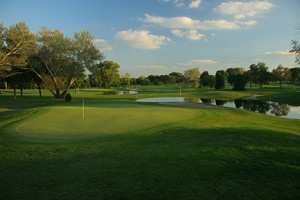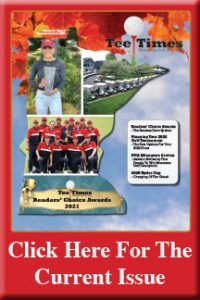Highland National Golf Course
By R.J. Smiley
For the last fifteen years the game of golf has been on a downward trend. For various reasons more players are dropping out of the game than are starting to play golf. Over the past few years hundreds of golf courses all across America have closed. Some of these golf courses have been converted into real estate developments; others have become a strange looking patch of weeds.
In most American communities the local municipal golf course is considered a valuable community asset. Even though, in many cases the golf operation is subsidized by taxpayer dollars. Lifelong residents view their golf course with a true sense of pride. Making statements like, “That is where little Billy learned to play.” Or, “Grandpa and Janie spent many evenings playing a few holes just before dark.”
During the second golf boom, (the Go Go 1980s) upscale daily fee golf courses became popular. Golfers were forced to make a choice – do I play the local muni that is in poor condition? Or do I pay a few dollars more and play a modern course that is in great shape? As more regular muni players chose to play the more expensive, but better conditioned newer courses, more cities were forced to make a choice.
Improve Our Product Or Lose Money??
The City of St. Paul chose to improve the product! The transition from Highland Park Golf Course to Highland National Golf Course occurred between 2003 and 2005 – the construction years. During that two-year period of time, a tired old golf course that had been in continuous operation since 1927 was transformed into a modern day golf course that can be enjoyed by golfers of all abilities. The severe drainage problems that had plagued the old course since its inception were rectified by a series of “step ponds.” Each pond flows through a culvert into the next, lower level, pond in a series of steps. The final pond in the series drains into a storm sewer that empties into the Mississippi River. Golf course architects Garrett Gill and Paul Miller worked hand in hand to oversee the construction of the best-located golf course in St. Paul. McCrossan Construction did the earth moving and fashioned the series of step ponds to perfection.
The first round was played on Highland National Golf Course in late May of 2005. The look and feel of the new golf course and its predecessor, which stood for almost 80 years, were completely different. The only thing that remained was the physical characteristics of the property. Highland National looks like a flat golf course and it feels like a flat golf course. Golfers never feel like they are walking up or down hill. But whether you were playing the old Highland Park or the new Highland National there is still a 100′ drop from the base of the Highland Park water tower to Hamlin Avenue – a half a mile away. What does this mean for golfers who play the course? Playing golf at Highland National is like playing golf on the seashore, every putt breaks toward the water, in this case the Mississippi. Grain, like the hair on dogs back, causes all putts to move toward the water. Once you understand that fact, your scoring will improve. Also, hit one more club on #2, #13 and #14 as they are up hill even if you can’t see it.
Highland National was constructed on the natural soils found within the property, mostly clay. The biggest job that Golf Professional/Manager, John Shimpach, and very capable maintenance staff have is to keep the turf healthy and lush. The smooth putting surface of the greens is due to the L-93 Bent Grass that was recommended for the new course. John says, “We work hard at not allowing the Poa (native grass/weed that creeps in and overtakes greens and fairways) to invade our greens.”
Snoopy, the quick witted dog that is an integral part of the Peanuts comic strip, proudly guards the 15th fairway with a sand trap shaped in his image. The Snoopy bunker, that was placed on the course as a tribute to Charles M. Schulz, the cartoon’s creator who was a regular at Highland Park for years. CNN rated the new course with its Snoopy shaped bunker in the top eleven city owned courses in America. Speaking of celebrities, Joe Mauer, the $23 million a year first baseman for the Twins grew up playing golf at Highland with his brothers.
Highland National is a finished product. When asked what future changes were on the drawing board for the course, Shimpach stated that the course could use a little more length, especially on holes #1 and #18. He also added that all of the tees on the par-3 holes could be enlarged. “Looking in the rear view mirror it would have been wise to bite the bullet during construction and make the tees larger.”
Highland National is home of the Sanford First Tee Learning Center. The City of St. Paul is dedicated to growing golf through junior golf programs. The Highland Park Executive Golf Course was not changed during the reconstruction and is a favorite among St. Paul residents who don’t have the time or desire to play a full sized championship golf course.
During the transition, everything on the golf course was changed except the clubhouse. In 1927 when Highland Park Golf Course was opened, the city wanted a clubhouse with that special character. Clarence “Cap” Wigington, one of only a hand full of African-American architects in the U.S., and the first black architectural designer for the City of St. Paul was asked to complete the task. The Highland National clubhouse and the Highland Park water tower (the water tower behind the 14th green) were both designed by Wigington and built during the same time period. The Highland Park water tower was placed on the National Register of Historic Places in 1986. Many believe that the clubhouse at Highland National will someday join the tower on the register. Wigington also designed the Holman Field Administration Building and the Harriet Island Pavilion, both on the historic register.
Wigington was the founder of the Home Guards of Minnesota, an all-black militia in 1918 when racial segregation prohibited his entry into the Minnesota National Guard. He was awarded the rank of Captain, thus the name “Cap.”
When asked why the golf course was named Highland “National,” there was no clear-cut answer. Some say that they wanted to be looked upon in the same eyes as famous Hazeltine National. But others believe that it was done as a tribute to Cap Wigington for his timeless work on the nationally recognized tower and the little sister clubhouse. When you are having the post round beverage notice the original marble dance floor where the tables now sit.
Same historic clubhouse. Same great location. Time for a round on the New Highland National.

Highland National Clubhouse





